For the first time, using a neutrino telescope and ANRI effect in the study of solar activity, a low class solar flare was recorded. Given the high theoretical and applied interest in nature and the manifestation of solar flares, we note that the neutrino telescope expands the capabilities of the researcher: the existence of the neutrino component of the solar flare is shown.
Solar Flares; Solar Neutrino Flux; ANRI Effect
The present study was intended as a current, almost regular plan with a fairly ordinary result in advance. What was originally taken as an unknown external influence remained without careful study and only an exact coincidence with the solar flare moment, even if weak (class C), changed the structure of the study. As is well known, the study of solar flares is a subject of rapt attention and deserves both theoretical and experimental efforts. Already an early study of sunspots and recognition of the role of magnetic hydrodynamics led to conclusions about the special formation of flares (in the vicinity of the sunspot group, but outside the sunspot) [1]. According to Internet surveys, a solar flare as an explosive process of isolating different types of wave energy and solar matter emission has been studied in great detail, and since powerful flares are dangerous for society (energy release ~ 6 X 1025 Joules), much attention is paid to their prediction. Advances in the forecast of powerful outbreaks are quite modest and not deep in time - about 3 days. The power is determined in W / m2, the flash duration is ~ several minutes, the composition is mg-waves and plasma, the optical X-ray radiation reaches the Earth in 8.5 minutes, after several tens of minutes - powerful streams of charged particles and plasma clouds - after 2.3 days. The works in which solar neutrinos would be mentioned in the flare were not found, but there are studies that lead to serious conclusions [2].
Experiment
On April 4, the solar neutrino flux was observed at the intersection of the axis of the neutrino telescope equipped with a temperature detector of the neutrino flux. There was expected as usual to obtain interference patterns. (Figure 1)
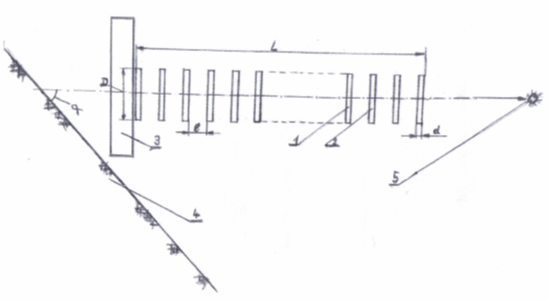
Figure 1: Neutrino Telescope. The simplest series of regular disks from radioisotopes, where: L is the total length of the series; D-diameter of the disk; d is the disk thickness; l is the distance between the disks; - - - the axial line; 1.2 — Disks of the ∑N series, where N is the number of disks, α is the angle of installation of the telescope axis with respect to the basement plane, 3-temperature detector, 4 is the basement plane, - 5 neutrino source (Sun)
The temperature detector is installed at the rear of a row of disks, while the outermost disk is on the opposite side facing the solar disk, which intersects along the normal and diameter with an axial line due to the rotation of the Earth. The purpose of the recording was to obtain a form of heat flux perturbation on the telescope detector during the passage of the solar neutrino flux during the intersection of the solar disk. Signal recordings with a 4-minute averaging of its level are statistically almost regular in nature and refer to the initial stage of the study (for example, the construction of diffraction patterns).
However, on April 4, the observation process was accompanied by unforeseen features (see Figure 2). In addition to the usual temperature increase caused by the passage through the maximum of the solar neutrino flux (N = 6x1010 particles / sec. Cm2), there was another narrow peak with an amplitude that does not require confirmation of the reliability by statistical estimates. To search for the causes of its origin, publicly available data on solar flare activity were analyzed (Figure 3).
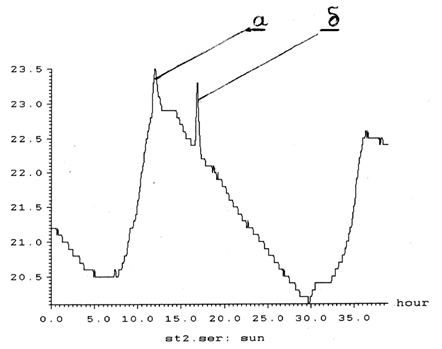
Figure 2. The Usual Temperature Record is the Peak associated with the Passage of the Solar Maximum or the main Peak (a), and the Peak associated with the Flash on the Sun (b), the Arrow indicates the Flash Point - T = 15h 52m UT
Peak (b) figure 2 in time exactly corresponds to the peak of the solar flare (Figure 3). Figure 4 shows the spectral - time analysis (chart) of Figure 2 data, according to which the observation period is clearly visible, having a gap at the moment of appearance of the pic.2, 3 peaks, since their amplitude did not correspond to the overall periodicity.
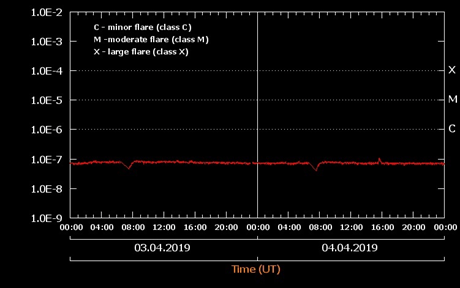
Figure 3. Data of the Flare Activity of the Sun for 04/04/2019. At 15h 52min there is an Outbreak of Activity on the Sun in the form of an insignificant but Significant Peak (marked by an arrow), - T = 15h 52m UT
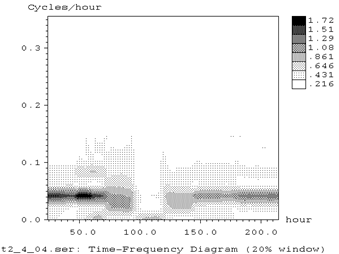
Figure 4. Spectral - Time Analysis (STA) Data Figure 2
Were compared records of observations of the activity of the Sun for 4.04. and 5.04. 2019 by calculating the mutual correlation function between observations of the Sun for 4.04 and 5.04. 2019 y. approximately at the same time intervals (Figure 5).
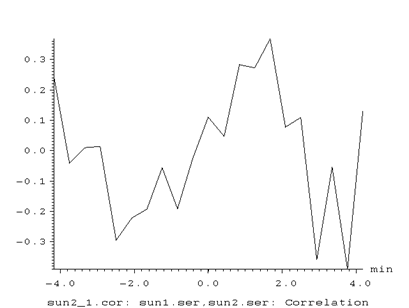
Figure 5. Mutual Correlation Function of Records of Neutrino Fluxes of the Sun for 4.04 and 5.04. 2019 y
As follows from Figure 5, the maximum correlation corresponds to the zenith orientation of the neutrino telescope to the solar disk. According to both of the above analysis and observational data, a flare at the Sun is accompanied by a powerful jet of neutrino ejection. Let us estimate the ejection power (peak b) by comparing it with the main signal (peak-a), that is, by the amplitudes of the peaks a) and b). According to Figure 2, peak a) is 23.5 С0 and peak b) is 23. 3С0 that is, their flows are comparable. If we assume that the peak b) appeared due to the growth from the peak curve a), then the power of its flux will be ~ 1C0 or ~ 109 neutrinos / cm2sec. Since a registered flash cannot be classified as a powerful one, this means that sufficiently powerful flashes according to the Catalog are accompanied by significantly larger neutrino emissions. Thus, observation of the solar disk with the help of the neutrino telescope [3] made it possible to detect a new type of solar flare, which, according to the adopted name system, should be called neutrino. According to [2], when the Sun is activated, extensive flare fields are observed, i.e., neutrino output from large areas of surface or near-surface structures and / or (volumes) of the central zone is emitted in the form of isolated powerful streams of limited diameter and not sufficiently strictly directed along the normal (radius of the Sun ). Therefore, the existing estimates of the real flux without these features need to be revised, as well as the severity of the problem of the lack of neutrinos (never doubting the effect of neutrino oscillations). The existence of neutrino flares indicates their deep connection with the central zone or core of the Sun, which is in good agreement with the existence of the previously known [2] 11-year cycles, which speaks in favor of the influence of flares on volcanic and seismic activity. Similar effects, such as the role of solar neutrinos, in the activation of a volcano were also investigated previously [4]. As is known, proton flares are most suitable for forecasting flare activity. Neutrino flares are also likely to have good chances. Moreover, their registration in standby recording mode is easy and affordable. At the same time, if the intensity of the neutrino flux is moderate enough, then its impact on the seismically active region will lead to a decrease in the level of seismicity. Occur, as expressed by the famous physicist V. Tsarev, earthquake prevention. And the last - super flashes - the events are not frequent, but their manifestation involves many well-known dangers for modern civilization. The most powerful neutrino flux from such a flash will in itself be the source of many troubles: the explosive eruption of volcanoes in a near-critical state; growth of general and regional seismicity; unpredictable damage and accidents on nuclear systems and reactors, primarily nuclear power plants; the likely failure according to theoretical estimates of the failure of a nuclear weapon. So physicists from the Japanese KEK laboratory at the University of Hawaii showed that with a certain technical progress in the future, a neutrino beam can be used to detect and destroy enemy nuclear weapons. Unfortunately, an even more powerful beam is likely with a super flash, and its effectiveness guarantees the existence of the ANRI effect [5]. Earlier, in the study of lunar seismicity of flare origin, anomalies of seismograms were observed, which were interpreted as a manifestation of the neutrino fluxes of the Sun [6].
1. Solar flares are accompanied by a powerful neutrino flux.
2. Solar flares are simple and affordable to register with a neutrino telescope.
3. The danger of super flashes greatly increases due to the simultaneously emerging powerful neutrino flux.
4. The neutrino component of solar flares can play a prominent role in Earth geophysics.
- Bray R, Loughead R (1964) SUNSPOTS. The Astrophysics Series 7. [crossref]
- Khavroshkin OB (1982) Solar flares. Siberian Branch of the Academy of Sciences of the USSR, Siberian Institute of Terrestrial Magnetism, Ionosphere and Radio Wave Propagation. 247.
- Khavroshkin OB, Tsyplakov VV (2019) Neutrino Telescope and the Effect of Anomalic Neutrino Radia - Isotope (Anri) Absorption. Eng phys 2: 3-13. [crossref]
- Khavroshkin OB, Fedotov SA, Tsyplakov VV, et al. (2019) Volcanology and New Geophysics: Reality and Prospects on the Example of Yelloustonsky Volcano. Volcanology and Seismology 1: 25–35. [crossref]
- Khavroshkin OB, Tsyplakov VV (2018) Five Years after Discovery Abnormal Neutrino Radioactive -Isotope (ANRI) Absorption. OALib 5: 1-17. [crossref]
- Tanaka Satoshi, Khavroshkin OB (2014) Solar flares: seismic fields of the Moon and Earth. Eng Phys 8: 29-41. [crossref]





